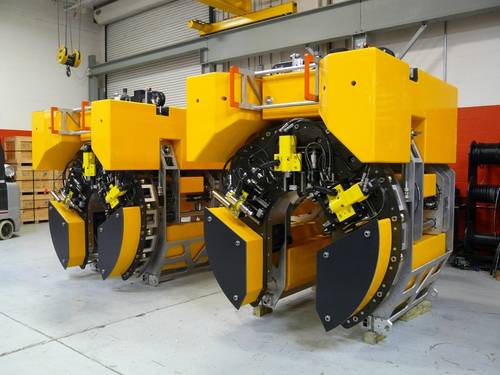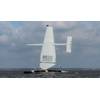Wachs Subsea CPT Combination Prep Tool
When looking for an emergency preparedness system for the GoM and elsewhere, Chevron partnered with Wachs Subsea to create a highly automated pipeline repair system that utilizes our Combination Prep Tool (CPT) as the key operational component.
The CPT-3, or Combination Prep Tool Generation 3, is a hydraulically powered subsea machining system equipped with three modules that perform five functions: cutting, beveling, counterboring, weld seam removal and FBE removal. The CPT machine itself is comprised of a twin clamp, open "C" framed rotary machining platform with a universal mounting interface for the attachment of the three modules. Each module is equipped with a subsea camera for live monitoring.
The CPT-3 features the ability to transit ("walk") the axis of the pipe, utilizing a caterpillar action of alternating clamps, pushing and pulling between the two. It's part of a cut, lift, remove and replace system designed to machine subsea pipelines from 12" to 24" OD (DN300-600) at depths up to 3,000 meters (9843 sfw) prior to installation of the replacement spool. Available soon is the CPT-4, utilizing the same technologies as the CPT- 3 but scaled up in size and capabilities to accommodate pipelines in the 26" to 44" OD (DN650-1050) range.
The CPT-3 is compact, measuring 70.75" (180cm) long by 72" (183cm) wide by 56.25" (143cm) high (machine only, without the deployment frame). Weight in air for the machine itself is a comparatively light 6000 lbs (2721 kg). With its deployment frame, tooling and fluids lifting weight is approximately 11000 lbs (4990 kg). Weight in sea water is virtually neutral buoyant at 50 lbs negative (23 kg), user adjustable.
All clamping, walking, cutting, beveling and removal operations are controlled remotely via the included CPT iVP controller program, running on a dedicated laptop included with the system. The graphical user interface on the iVP software is highly intuitive, allowing for ease of use without the need for intensive operator training, Wachs said.
The CPT series is engineered and built to ISO 9000-2008 standards. Constructed with aluminum, epoxy coated syntactic flotation, stainless steel, bronze and heat treated carbon steel with protective plating, the CPT also includes cathodic protection, all designed to resist corrosion. Hydraulic and electrical systems are equipped with depth compensation for deepwater operation under extreme pressure, and include an advanced warning system to detect seawater infiltration.
Deploying the machine begins by positioning the CPT in its custom deployment frame on the seabed, in close proximity to the repair site. The deployment frame features a single pivot arm for ease of lowering and lifting, a mudmat to prevent stiction on the seafloor and to help minimize silt clouding. The CPT clamps to a center fixture on the frame for transport and storage. As pressure compensation is integrated into the CPT, the deployment frame requires no additional compensation.
Wachs said the CPT-3 is compact and light enough to be deployed with a wide array of ROVs, and is energized and powered via electrical and hydraulic zero leak hot stabs. The pipeline repair begins with the ROV clamping the CPT to the pipe near the initial cut line. The CPT Severing/OD Bevel module performs the severing operation, with the hydraulic autofeed system producing pinch-free severing with a smooth, controlled cutting action for pipelines under compressive loading.
The CPT is then transited to the second cut line, where the operation is repeated. The replacement jumper spool section, following metrology measurements, is typically fabricated topside at this stage. Following removal of the damaged section the CPT bevels the pipe OD to prevent sleeve connector damage when installing the sleeved replacement spool section.
The Weld Seam Removal module utilizes a combination face mill and ID bevel tool to face mill the weld crown for a smooth mounting surface, and indexes and pull mills the ID creating an internal bevel to prevent pig snagging. The final prep has the FBE Removal module abrading the FBE (fusion bonded epoxy) off the pipe with a high speed rotary abrasive disk, utilizing a combination of axial indexes and radial rotation to deliver unlimited axial removal lengths.
The CPT system is designed to carry out all severing and preparation work in a single deployment. Upon completion the machine is unclamped and flown back to its deployment frame by the ROV. The entire frame and machine is then hoisted topside, leaving nothing on the seabed. The machine is then cleaned and prepped for the next deployment, or for storage.
Wachs Subsea said its CPT represents the latest thinking in subsea pipeline repair and emergency preparedness. It's a single multifunctional machine, with its compact size and light weight allowing it to be air lifted within hours to any contamination site. Its size eliminates the need for a large surface support ship or for a heavy workclass ROV to deploy it. And like all Wachs products the CPT is built to last, with high quality components that require minimal maintenance, plus a small footprint for storage.
wachssubsea.com


















 February 2024
February 2024



